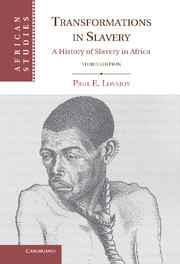Book contents
- Frontmatter
- Contents
- Maps and Tables
- Note on Currencies, Weights, and Measures
- Preface
- Preface to the Second Edition
- Preface to the Third Edition
- 1 Africa and Slavery
- 2 On the Frontiers of Islam, 1400–1600
- 3 The Export Trade in Slaves, 1600–1800
- 4 The Enslavement of Africans, 1600–1800
- 5 The Organization of Slave Marketing, 1600–1800
- 6 Relationships of Dependency, 1600–1800
- 7 The Nineteenth-Century Slave Trade
- 8 Slavery and “Legitimate Trade” on the West African Coast
- 9 Slavery in the Savanna during the Era of the Jihads
- 10 Slavery in Central, Southern, and Eastern Africa in the Nineteenth Century
- 11 The Abolitionist Impulse
- 12 Slavery in the Political Economy of Africa
- Epilogue
- Appendix Chronology of Measures against Slavery
- Notes
- Select Bibliography
- Index
- Books in this series
3 - The Export Trade in Slaves, 1600–1800
Published online by Cambridge University Press: 05 June 2012
- Frontmatter
- Contents
- Maps and Tables
- Note on Currencies, Weights, and Measures
- Preface
- Preface to the Second Edition
- Preface to the Third Edition
- 1 Africa and Slavery
- 2 On the Frontiers of Islam, 1400–1600
- 3 The Export Trade in Slaves, 1600–1800
- 4 The Enslavement of Africans, 1600–1800
- 5 The Organization of Slave Marketing, 1600–1800
- 6 Relationships of Dependency, 1600–1800
- 7 The Nineteenth-Century Slave Trade
- 8 Slavery and “Legitimate Trade” on the West African Coast
- 9 Slavery in the Savanna during the Era of the Jihads
- 10 Slavery in Central, Southern, and Eastern Africa in the Nineteenth Century
- 11 The Abolitionist Impulse
- 12 Slavery in the Political Economy of Africa
- Epilogue
- Appendix Chronology of Measures against Slavery
- Notes
- Select Bibliography
- Index
- Books in this series
Summary
By 1600, an important structural change in the political economy of some parts of Africa was well underway. Islam continued to be an agent of change in the northern savanna and along the shores of the Red Sea and Indian Ocean. Slaves were exported on a sustained level, and enslavement and slavery were still interpreted largely in terms of Islamic law and tradition. The growth of the trans-Atlantic slave trade had already exposed west-central Africa to a radically new influence. In the next two centuries, this influence was to have an even greater effect on much of the Guinea coast than the earlier trade in slaves had had anywhere in Africa, with the result that the people of the Atlantic basin experienced a major transformation in social organization. The dynamic changes along the Atlantic shores where the export trade became so substantial in the seventeenth and eighteenth centuries transformed slavery there in ways quite different from the earlier pattern in the Islamic belt, although structurally the impact was the same: Where slaves had once been an incidental element in society, they now became common. The ability to supply slaves required adjustments in the methods of enslavement and the development of a commercial infrastructure. These changes in turn were accompanied by increased domestic use of slaves.
The Volume of the Export Trade, 1600–1800
Despite the unevenness of the data available for a census of the export trade in slaves, it is possible to make some broad comparisons between its various sectors (see Table 3.1). The trade increased steadily from the sixteenth to the eighteenth century. The total number of slaves who left Africa – about 1,088,000 in the sixteenth century – includes 750,000 slaves allocated to the Islamic trade and 338,000 for the trans-Atlantic trade. The estimate for the Islamic traffic could be significantly off the mark but is unlikely to be less than 500,000 or more than 1,000,000. The estimate for the trans-Atlantic movement is far more accurate. Hence the sixteenth-century migration probably was on the order of 800,000 to 1,300,000 people. The seventeenth-century trade is subject to less error, and the eighteenth-century trade to less still, because the proportion of the trans-Atlantic trade – which can be estimated far more accurately than the Islamic trade – steadily increased, thereby reducing the relative size of the Islamic trade and correspondingly minimizing the error inherent in an assessment of its volume.
- Type
- Chapter
- Information
- Transformations in SlaveryA History of Slavery in Africa, pp. 45 - 65Publisher: Cambridge University PressPrint publication year: 2011

